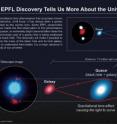Astrophysicists discover a quasar that acts as a cosmic lens
A quasar acting as a gravitational lens has now been observed for the first time. This discovery, made by the EPFL's Laboratory of Astrophysics in cooperation with Caltech, represents an advance in the field, since it will allow scientists to weigh and measure a galaxy that contains a quasar. The news is published today in the journal Astronomy & Astrophysics. Gravitational lenses are common throughout the universe. They are caused by massive objects such as stars or galaxies that bend rays of light passing nearby. If these objects are between the earth and a more distant light source, the light will therefore be brighter and easier to observe, but also very distorted. If the alignment of the various stellar bodies is almost perfect, the image of the source will be multiplied.
The lens phenomenon is not only an interesting result of Einstein's theory of general relativity; it has also been a valuable astrophysical tool with important applications in the search for extrasolar planets and the study of stars, galaxies, clusters of galaxies and quasars. For example, the nature of the distortion, the number of images of the most distant objects and their position in the sky provide essential information about the distribution of matter in the lens galaxy and allow a measurement of its total matter, including dark matter, to be made.
A quasar is the heart of a galaxy, consisting of a supermassive black hole. The small fraction of the galaxy's mass that is close enough to be swallowed up by the black hole emits light before disappearing forever, giving rise to this extremely bright and transient phenomenon.
To date, about a hundred of these quasars emitting light that is concentrated by a lens galaxy located between them and the earth have been discovered. However, this is the first time that the opposite case has been observed, where the quasar is in the foreground and the galaxy behind it. The interest of this discovery lies in the fact that it provides an unprecedented opportunity to "weigh" a galaxy containing a quasar.
This advance was made thanks to the SLOAN Digital Sky survey database (www.sdss.org), which makes three-dimensional sky maps covering more than a quarter of the sky available to scientists and contains nearly a million galaxies and over 120,000 quasars. A sample of some 23,000 of these quasars in the northern hemisphere was selected by the Laboratory of Astrophysics team. In the end, only four of them seemed to act as a gravitational lens.
One of these was studied using the Keck telescope (Caltech) on Mauna Kea peak in Hawaii. These images will be supplemented in the coming months with very high-quality photographs from the Hubble Space Telescope, which will reveal more about the nature of this particular quasar.
Source: Ecole Polytechnique Fédérale de Lausanne
Other sources
- Astrophysicists discover a quasar that acts as a cosmic lens (w/ Video)from PhysorgTue, 20 Jul 2010, 19:49:24 UTC
